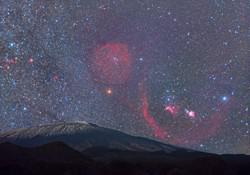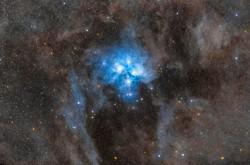Glossary term: Milieu interstellaire
Description: Le milieu interstellaire (ISM en anglais) est un terme qui désigne l'ensemble du gaz et de la poussière qui se trouvent entre les systèmes stellaires d'une galaxie. Notre système solaire se trouve dans le disque de la Voie lactée, où la majeure partie du MIS est constituée d'hydrogène atomique mélangé à de l'hélium atomique et à de la poussière.
Le milieu interstellaire a une densité très faible par rapport aux atmosphères planétaires, avec une densité typique inférieure à une particule par centimètre cube, soit environ 50 milliards de milliards de fois moins dense que l'atmosphère terrestre. Cette densité varie considérablement, de même que la température, à travers la galaxie, le milieu interstellaire étant divisé en plusieurs composantes différentes.
Les composants les plus importants en volume dans le disque galactique sont le gaz atomique chaud et le gaz ionisé chaud, dont les températures avoisinent les 8 000 kelvins (K) et dont la densité est d'environ un demi-atome ou ion par centimètre cube. Un volume plus petit se présente sous la forme de gaz atomique plus froid et plus dense, dont la température est d'environ 40 K. Un volume encore plus petit du milieu interstellaire se présente sous la forme de nuages d'hydrogène moléculaire plus denses (jusqu'à un million de molécules par centimètre cube) et plus froids (<20 K). Certains de ces nuages moléculaires s'effondreront sous l'effet de leur propre gravité, entraînant la formation de nouvelles étoiles. Les nuages moléculaires de la Voie lactée se trouvent principalement dans ses bras spiraux. Le gaz entourant le disque de la Voie lactée est très chaud (des millions de kelvins) et de très faible densité.
Les étoiles rejettent du gaz et de la poussière dans le milieu interstellaire par l'intermédiaire des vents stellaires et des supernovae. Le gaz et la poussière renvoyés dans le milieu interstellaire contiennent une plus grande proportion d'éléments lourds (métaux), ce qui enrichit la galaxie au fil du temps. Le gaz et la poussière présents dans le milieu interstellaire sont la principale cause de l'extinction interstellaire.
Related Terms:
- Poussière
- L'extinction
- Disque galactique
- Gaz
- Voie lactée
- Nébuleuse planétaire
- Système solaire
- Vent solaire
- Spiral Galaxy
- Formation des étoiles
- Supernova
- L'extinction interstellaire
See this term in other languages
Term and definition status: The original definition of this term in English have been approved by a research astronomer and a teacher The translation of this term and its definition is still awaiting approval
The OAE Multilingual Glossary is a project of the IAU Office of Astronomy for Education (OAE) in collaboration with the IAU Office of Astronomy Outreach (OAO). The terms and definitions were chosen, written and reviewed by a collective effort from the OAE, the OAE Centers and Nodes, the OAE National Astronomy Education Coordinators (NAECs) and other volunteers. You can find a full list of credits here. All glossary terms and their definitions are released under a Creative Commons CC BY-4.0 license and should be credited to "IAU OAE".
If you notice a factual or translation error in this glossary term or definition then please get in touch.
Related Media
Orion Rises Over Mount Etna
Credit: Dario Giannobile/IAU OAE
License: CC-BY-4.0 Creative Commons Attribution 4.0 International (CC BY 4.0) icons
The Pleiades M45 with Majestic Dust
Credit: Mohamed Usama/IAU OAE
License: CC-BY-4.0 Creative Commons Attribution 4.0 International (CC BY 4.0) icons










